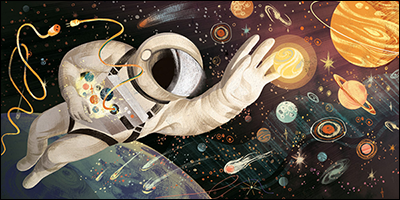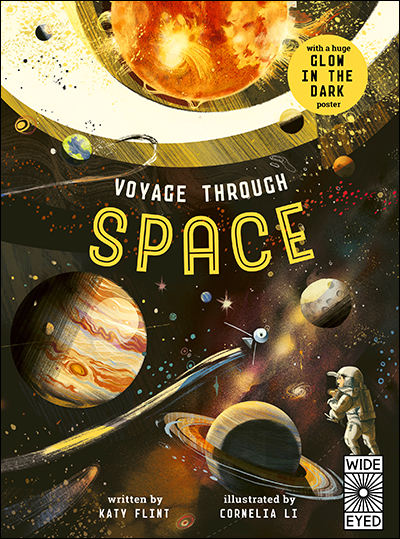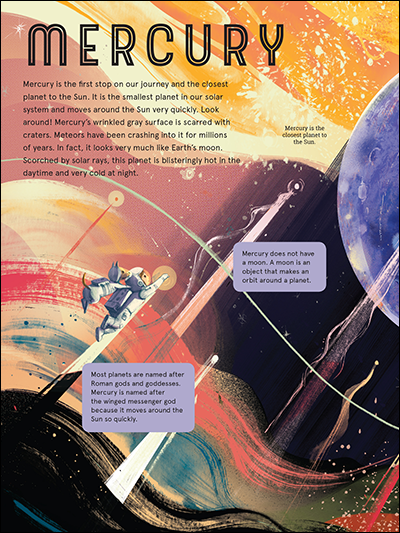
I first discovered Cornelia Li’s work in National Public Radio Correspondent Allison Aubrey’s report “From Gloom to Gratitude: 8 Skills to Cultivate Joy”—for which Cornelia made a beautiful illustration (where the wonderfully drawn koi caught my eye). This led me to discovering her artwork for children’s books, like “Voyage Through Space.” In addition to the cosmic perspective, here she shares her perspective on becoming an illustrator, a creative discipline she is passionate about—and it shows in her art.
How did you arrive at the desire, ultimately the decision,
to become an artist who makes her art her life’s work?
My interest in being a visual artist stems very early in my childhood. From as far back as I can remember, I’ve always used drawings to communicate ideas and emotions (such as cartoons of my dad’s teeth falling out or stinking when he didn’t shower for one evening). I am fortunate enough to have parents who supported me through this decision and have always encouraged my interest in art.
It wasn’t until university that I learned the concept of “illustration.” Immediately, I found the use of visual language as a means of problem-solving very intriguing. I like the idea of having a real-world application for my art, while maintaining my own artistic vision and voice, and being an illustrator just fell naturally in place for me.
Your work spans illustrations, murals and books. Which area of practice was engaged first? How did you get interested in each medium? How do you maintain practicing each discipline?
I started with and still predominantly work in editorial, as it is relatively accepting to new talents and was easier to break into for a new graduate. I enjoy coming up with visually interesting and meaningful representation for the variety of topics and the thrill of the fast turnaround time. The process of working on an editorial usually starts with reading the articles, which actually educate me on many topics I would not have actively learn.
Book illustration is something that I only got a chance to work on more recently. The narrative approach that many of the book projects require actually contrast nicely with the more metaphorical approach taken with editorial illustrations. It gives me the mental breaks I need!

What methods/activities did you activate to help you actually start working and living your passion?
Going to art school, being introduced to the art community, and constantly feeling inspired by the talents surrounding me definitely keep me motivated in both creating art—and learning to be better at what I do. Getting business advice from profs and design forums are also vital to being a sustainable illustrator, as you are not simply an artist but also the runner of this one-person business.
On a more day-to-day basis, my way of staying motivated is really just sitting down and starting to move the pencil (or Stylus), and my mind will settle into working mode.
What experiences do you carry with you that empower your work moving forward?
As an illustrator, I don’t think there are any aspect of life experiences that’s completely unrelated to my work. My work is the product of my mind—and my mind is an accumulation of different life experiences. In particular, I draw inspirations from literature, observations of people and nature, including past and contemporary masters. I also try to be on top of news relevant to my industry.
Being an indie creator, what does independence and growth mean to you?
Being a freelance artist isn’t just a job, it’s also a lifestyle. Going back to the point that every life experience contributes to my work, my mind is always engaged in searching for visual inspirations and possible solutions. On the management side, I try to keep a routine, even though I work from home; it’s easy to get wrapped up in work and forget to take breaks. I usually start the day at around 8:30–9 in the morning, dealing with the most challenging and thinking-involved tasks, then going down the to-do list. I try to end my day at around 6, go out for a walk, and make time to do other things such as reading and cleaning my place. I also have a cockatoo-studio mate named Charlie who perches himself on my desk top monitor and occasionally destroys a thing or two.

When you engage an editorial illustration project, can you walk through your process? For example, how did you realize “Quebec Science: Ordering Genes”?
Over the years, I manage to develop a pretty consistent process with editorial work. I usually start with reading the article, take notes on key concepts and points, then begin thumbnail on paper or on the computer. While the art director requires 3 concepts, I often explore many more, of different visual symbols and metaphors that can most effectively convey the article. Once the concept is approved, I move on to the final illustration. For editorial, I do the final illustration (below) almost exclusively in digital media.

Thank you! I was really fortunate; it was Quarto Publishing who approached me first after discovering an editorial piece I did (below) for the “Financial Post” depicting an astronaut harvesting stars. It has always been my dream to illustrate for books and I was so thrilled to get the email. After going back and forth with the author/editor, the wonderful Katy Flint, and the art director Nicola Price (who created amazing layouts!), we decided the book will be visual heavy with full spreads, starring a young astronaut and her canine companion who will accompany young readers during their exploration through the solar system. Together, they explore the sun, the eight planets, in addition to the astroid belt and Kuiper belt, finally arriving at a glow in the dark poster of the solar system.




Do you have usually a sketchbook on your person? What’s your frequency in making time to sketch? Is this one of the major ways you practice drawing and sharpening this skill?
I actually don’t work in sketchbooks but loose sheets of scrap paper. I find that while working in sketchbooks, I am always afraid to ruin them, which actually inhibits the flow of my creativity. Because my sketching process is an exploration of ideas, my sketches are actually quite ugly and illegible compared to artists who have beautifully rendered sketchbooks! That said, I do make chicken-scratch sketches quite often, as it is a way to keep my mind active. My current goal is to explore the analogue medium more, so perhaps I will return to a proper sketchbook soon.
What is your vision of satisfaction and growth, as it relates to your livelihood?
I like to further expand on the types of project I do. I am currently working on personal projects in hopes of expanding into the publishing realm further, to work on book covers and middle-grade novels. I am also hoping to collaborate with design firms to work on campaigns. Further down the road, I am also hoping to collaborate with a designer brand—and design scarves for them!
How are creativity and art coping mechanisms in these politically-charged, ever-turbulent times?
I don’t think art is a coping mechanism so much as a mode of discourse. The visual language allows an artist to express their opinions or represent certain standpoints in the discussion of these issues, and through these discussions, hopefully creates resonance in the audience.
What is the one tool that helps make your work more accomplished and pleasant, as a result, making your life good?
Photoshop. It’s a powerful program—and with Kyle Webster’s Brushes, continuously good at mimicking the analogue medium with the benefits of time efficiency and control+Z. That said, I do want to get back into the analogue medium more. As convenient as the computer is, it cannot replace the touch of the pencil on paper.
How do you get the word out about what you do? How do you attract people to your work and hire you?
Like many artists, I started out with sending out postcards and cold emails to art directors. With internet and social media, it’s a lot simpler to find contact information. Entering competitions and trying to meet art directors in person also really helps. These days, not all my work comes from direct promotion; my published work is sometimes discovered by art directors and leads to new assignments. While it is really important to actively and consistently promote your work, I think having a strong body of work is what ultimately leads to jobs.
Social media is also extremely important nowadays and an excellent way to form a long-distance community. Admittedly, I am still improving my usage of social media.
In running your creative business and managing all of those moving parts to live and keep yourself busy, how do you take care of yourself?
This is only something I’ve recently gotten better at! These last two years, I’ve been trying to freelance as much as I can while doing a full-time job. Earlier this year, I got very very sick from overworking. After that, I decided to quit my full-time job and give full-time freelance a shot. As I mentioned earlier, I have a more established work schedule now; I force myself to disconnect from work in the evening for reading and other activities. I’m also living with my parents at the moment, so I have the privilege of not having to cook!
What’s your inspiration diet like? Who and what do you recommend to help stimulate creativity, even help overcome creativity-block?
I think we are fortunate to live in an age where resources and information are so readily accessible. I follow a variety of designers, artists and publishers on various social platform whose amazing work I find extremely inspiring. I also look for inspirations in old masters from the golden age of illustration.

If an aspiring illustrator approached you and said, “I love to draw and want to become a working artist,” what’s your response? What are some initial must-do steps to help kickstart such a career as productively as possible?
It’s a wonderful feeling finding your passion in life! The most important thing is finding your own artistic voice, and finding the audience for your work. Think about if you want to work for a studio or be a freelancer. The freelance lifestyle can be lonely and challenging, and not immediately rewarding. Develop a consistent and sustainable work habit. Engage in the community and support fellow artists. It’s also very important to take care of your health!
How does the city of Toronto, Ontario, contribute to your work? What makes it special for startups/business/creativity-at-large? Have you attended the CreativeMornings chapter?
I actually live in the suburbs outside of Toronto and don’t go to the city very often. That said, Toronto is a vibrant city for creative workers with an active network of designers and artists. There are many art communities and galleries, like those at 401 Richmond Street, which gives young artists the room to grow and explore.
Have you seen “Crazy Rich Asians”?
No. I read the plot summery on Wikipedia instead.
• • •
All images courtesy of Cornelia Li.
• • •
Read more from Design Feast Series of 105 (so far) Interviews
with people who love making things.
🖐🏾 Donating = Appreciating: Design Feast is on Patreon!
Lots of hours and pride are put into making Design Feast—because it’s a labor of love to provide creative culture to everyone. If you find inspiration from the hundreds of interviews, including event write-ups, at Design Feast, consider becoming a supporting Patron with a recurring monthly donation.
Help keep Design Feast going and growing by visiting my Patreon page where you can watch a short intro video plus view my goals and reward tiers, from $1 to $12—between a fun souvenir and a satisfying brunch.
